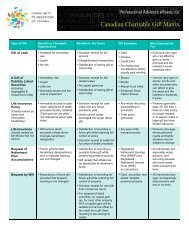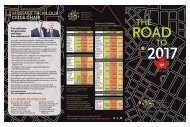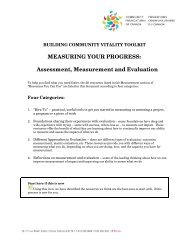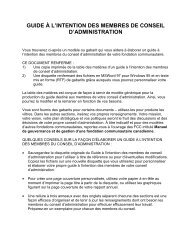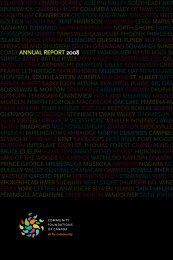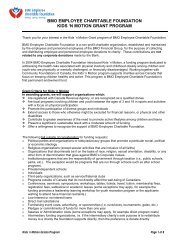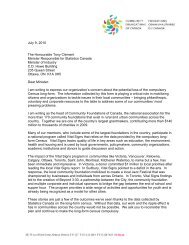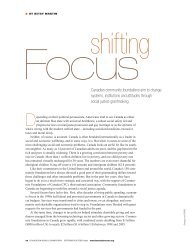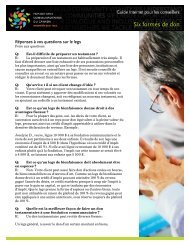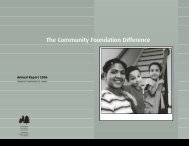Aboriginal Philanthropy in Canada: A Foundation for Understanding
Aboriginal Philanthropy in Canada: A Foundation for Understanding
Aboriginal Philanthropy in Canada: A Foundation for Understanding
You also want an ePaper? Increase the reach of your titles
YUMPU automatically turns print PDFs into web optimized ePapers that Google loves.
Across the Divide: Bridg<strong>in</strong>g Gaps <strong>in</strong> Knowledge<br />
& Understand<strong>in</strong>g<br />
The gulf between First Peoples and foundations <strong>in</strong> a number of areas was evident throughout the data<br />
collection <strong>for</strong> this report. We asked key <strong>in</strong><strong>for</strong>mants from foundations two questions to help us understand<br />
this issue:<br />
1. What do you need to know about First Peoples to develop better relationships?<br />
2. What do First Peoples need to know about philanthropy?<br />
Their responses fell <strong>in</strong>to several categories: length or term of fund<strong>in</strong>g; remoteness of some First<br />
Nation communities; navigat<strong>in</strong>g different processes; and recognition of diversity. However, key <strong>in</strong><strong>for</strong>mants<br />
emphasized that the most important factor <strong>in</strong> bridg<strong>in</strong>g the divide is respectful communication. Respondents<br />
from foundations and <strong>Aborig<strong>in</strong>al</strong> organizations stated clearly what was repeated <strong>in</strong> the literature: both<br />
parties need to clarify assumptions, <strong>in</strong>vestigate myths and have the ‘hard conversations.’<br />
Comments from <strong>in</strong><strong>for</strong>mants are presented below:<br />
• Un<strong>for</strong>tunately, many foundations do not take a long term view. With my limited experience work<strong>in</strong>g with<br />
First Nations, there have been concerns with regard to legal complications when provid<strong>in</strong>g services,<br />
such as tax issues – how do you tax First Nations? Accessibility is difficult on both sides because of<br />
remote locations. <strong>Aborig<strong>in</strong>al</strong> people like to meet and discuss face-to-face, which creates the issue of<br />
associated costs perta<strong>in</strong><strong>in</strong>g to travel. Navigat<strong>in</strong>g First Nations processes is difficult <strong>for</strong> funders.<br />
• We try to peg certa<strong>in</strong> situations and put them <strong>in</strong> the same place. There’s so much diversity with<br />
First Nations, Métis, Inuit, north/south issues, urban. We get some organizations that work with some<br />
communities and then become “experts.” As a foundation, we need to ma<strong>in</strong>ta<strong>in</strong> a balance between<br />
<strong>Aborig<strong>in</strong>al</strong> organizations and the ma<strong>in</strong>stream.<br />
• F<strong>in</strong>d the right synergies. Be flexible <strong>in</strong> your approach. If you’re rigid, and only fund green balloons, then<br />
the organization will become a green balloon. It doesn’t maximize community potential.<br />
• I feel there is a real need <strong>for</strong> a shift <strong>in</strong> th<strong>in</strong>k<strong>in</strong>g. E<strong>in</strong>ste<strong>in</strong> said that you can’t solve a problem with the same<br />
th<strong>in</strong>k<strong>in</strong>g that created the problem. I don’t th<strong>in</strong>k the sector realizes the depth of the changes <strong>in</strong> th<strong>in</strong>k<strong>in</strong>g<br />
that are needed to make real change. We need to work together to come up with new th<strong>in</strong>k<strong>in</strong>g so we can<br />
create someth<strong>in</strong>g better <strong>for</strong> all of us.<br />
• There are gaps <strong>in</strong> <strong>in</strong><strong>for</strong>mation. The difficulties <strong>in</strong> build<strong>in</strong>g personal relationships are huge; we don’t hear<br />
about, don’t know, don’t see <strong>Aborig<strong>in</strong>al</strong> people. They are separate; it is rare <strong>for</strong> people <strong>in</strong> the foundation<br />
community to know or see <strong>Aborig<strong>in</strong>al</strong> people. We are try<strong>in</strong>g to attract more <strong>Aborig<strong>in</strong>al</strong> people to come<br />
<strong>in</strong>to the foundation circle; foundations need to dig deeply to f<strong>in</strong>d ways to be a support. The challenges<br />
are there because of residential schools and the <strong>in</strong>tergenerational effects. There’s a different mode of<br />
communication; foundations are all about paper versus oral communication and traditions.<br />
• <strong>Foundation</strong>s are <strong>for</strong>ced to spread their resources th<strong>in</strong> and it is hard to <strong>for</strong>ge relationships over a long<br />
time. No one community has a really long relationship with a foundation. In the longer term ones, a<br />
special relationship develops.<br />
• We need to be respectful of the autonomy needs of the Nations – who they are, etc. We need to do<br />
our homework, what are the challenges, what do they face? For example, transportation, fuel to heat<br />
with; there’s noth<strong>in</strong>g worse than go<strong>in</strong>g <strong>in</strong> clueless: it’s disrespectful. We must do our homework – listen,<br />
recognize and respect.<br />
The Circle on <strong>Philanthropy</strong> & <strong>Aborig<strong>in</strong>al</strong> Peoples <strong>in</strong> <strong>Canada</strong> 26



